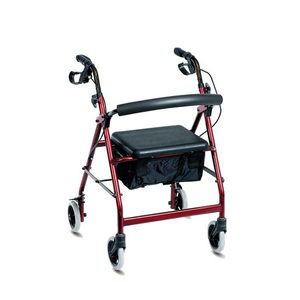The walking aids industry has seen significant growth in recent years, driven by an aging population and increased demand for mobility solutions. Manufacturers of Walking Aids play a crucial role in providing products that enhance the quality of life for individuals with mobility challenges. This research paper aims to provide a comprehensive analysis of the walking aids industry, focusing on the importance of quality manufacturing, key market trends, and the role of distributors and channel partners in the supply chain. By understanding these factors, manufacturers, distributors, and channel partners can better position themselves in the market and meet the growing demand for high-quality walking aids.
As the demand for Walking Aids continues to rise, manufacturers must prioritize quality, innovation, and compliance with industry standards. This paper will also explore the challenges and opportunities faced by manufacturers and distributors in this sector. For more information on the latest developments in walking aids, visit the Walking Aids section of Topmedi Wheelchair.
Market Overview of Walking Aids
The global walking aids market is expected to grow at a compound annual growth rate (CAGR) of 6.2% from 2023 to 2030. This growth is largely driven by the increasing prevalence of mobility impairments, the rising geriatric population, and advancements in assistive technology. Walking aids, including canes, crutches, walkers, and rollators, are essential for individuals who require support to maintain their balance, reduce the risk of falls, and improve mobility.
Manufacturers of Walking Aids must stay ahead of market trends to remain competitive. This includes investing in research and development to create innovative products that meet the needs of users. The demand for lightweight, foldable, and adjustable walking aids is on the rise, as consumers seek products that are easy to use and transport. Additionally, there is a growing emphasis on ergonomic designs that provide maximum comfort and support.
Key Market Drivers
Several factors are driving the growth of the walking aids market, including:
Aging Population: The global population is aging rapidly, with the number of individuals aged 65 and older expected to double by 2050. This demographic shift is increasing the demand for walking aids, as older adults are more likely to experience mobility impairments.
Rising Prevalence of Chronic Conditions: Conditions such as arthritis, osteoporosis, and neurological disorders can lead to mobility challenges, further driving the demand for walking aids.
Technological Advancements: Innovations in materials and design are leading to the development of more lightweight, durable, and user-friendly walking aids. For example, carbon fiber and aluminum are increasingly being used to create lightweight yet sturdy walking aids.
Increased Awareness: There is growing awareness of the importance of mobility aids in improving the quality of life for individuals with disabilities or mobility impairments. This has led to increased adoption of walking aids among both the elderly and younger individuals with temporary or permanent mobility issues.
Challenges Faced by Manufacturers
While the walking aids market presents significant opportunities, manufacturers also face several challenges. One of the primary challenges is maintaining product quality while keeping costs competitive. The production of high-quality walking aids requires the use of durable materials and precise manufacturing processes, which can increase production costs. However, consumers are often price-sensitive, particularly in developing markets, making it essential for manufacturers to strike a balance between quality and affordability.
Another challenge is ensuring compliance with regulatory standards. Walking aids are classified as medical devices in many countries, meaning they must meet strict safety and performance standards. Manufacturers must invest in testing and certification to ensure their products comply with these regulations. Failure to do so can result in costly recalls, legal liabilities, and damage to the brand's reputation.
Supply Chain and Distribution Challenges
In addition to manufacturing challenges, the walking aids industry also faces supply chain and distribution challenges. Distributors and channel partners play a critical role in getting products to end-users, but they must navigate complex logistics, particularly when dealing with international markets. Shipping delays, customs regulations, and fluctuating demand can all impact the timely delivery of walking aids.
Furthermore, distributors must ensure that they are working with reliable manufacturers who can consistently deliver high-quality products. Establishing strong relationships with manufacturers is essential for maintaining a steady supply of walking aids and meeting the needs of customers. For distributors looking to partner with a reputable manufacturer, Topmedi offers a wide range of high-quality Walking Aids and other mobility solutions. Learn more about their offerings on their Why Us page.
Importance of Quality in Walking Aids Manufacturing
Quality is a critical factor in the manufacturing of walking aids. Poorly designed or manufactured walking aids can pose serious safety risks to users, including falls, injuries, and reduced mobility. As such, manufacturers must prioritize quality control throughout the production process, from the selection of materials to the final inspection of finished products.
One of the key aspects of quality in walking aids manufacturing is the use of durable, lightweight materials. Aluminum and carbon fiber are popular choices due to their strength and weight-saving properties. These materials allow manufacturers to create walking aids that are both sturdy and easy to handle, making them ideal for elderly users and individuals with limited strength.
Quality Control Measures
To ensure the safety and reliability of walking aids, manufacturers must implement rigorous quality control measures. These measures include:
Material Testing: Ensuring that materials used in the production of walking aids meet industry standards for strength, durability, and weight.
Product Testing: Conducting tests to ensure that walking aids can support the weight of users and withstand regular use without breaking or malfunctioning.
Compliance with Regulations: Ensuring that walking aids meet all relevant safety and performance standards, such as ISO 11199 for walking aids and ISO 13485 for medical devices.
Customer Feedback: Gathering feedback from users to identify any potential issues with product design or performance and making improvements as needed.
Role of Distributors and Channel Partners
Distributors and channel partners play a crucial role in the walking aids supply chain. They act as intermediaries between manufacturers and end-users, ensuring that products are available in the right markets and at the right time. For manufacturers, working with reliable distributors is essential for expanding their market reach and ensuring that their products are accessible to a wide range of customers.
Distributors are responsible for managing inventory, handling logistics, and providing customer support. They must have a deep understanding of the walking aids market and be able to anticipate changes in demand. Additionally, they must ensure that they are working with manufacturers who can consistently deliver high-quality products. For distributors looking to partner with a reliable manufacturer, Topmedi offers a wide range of high-quality Walking Aids and other mobility solutions. Learn more about their offerings on their Service page.
The walking aids industry is poised for continued growth, driven by an aging population and increasing demand for mobility solutions. Manufacturers of Walking Aids must prioritize quality, innovation, and compliance with industry standards to remain competitive in this evolving market. Distributors and channel partners also play a critical role in ensuring that products reach end-users efficiently and effectively.
By understanding the challenges and opportunities in the walking aids industry, manufacturers and distributors can better position themselves for success. For more information on high-quality walking aids and mobility solutions, visit the Walking Aids section of Topmedi Wheelchair.






















